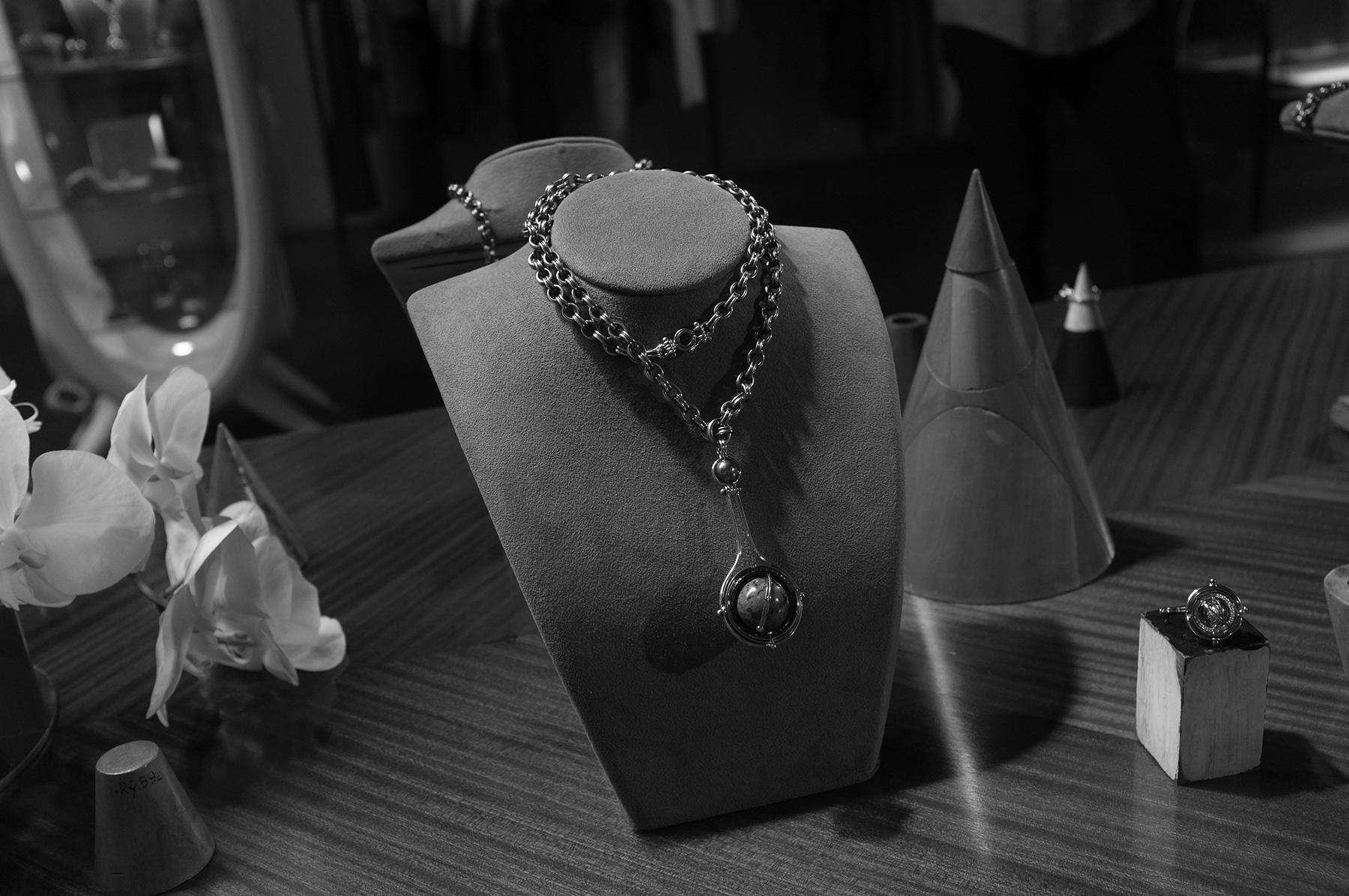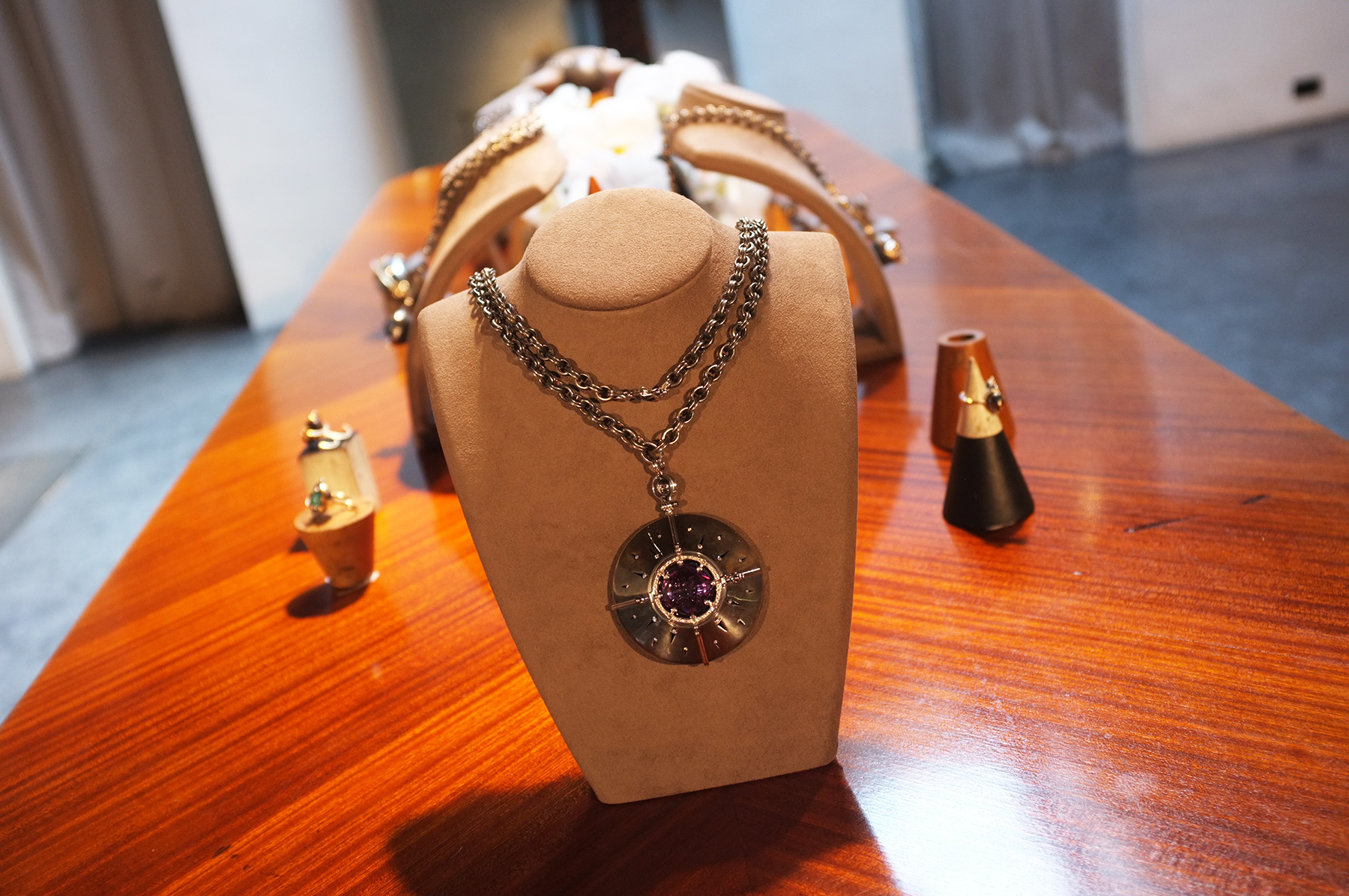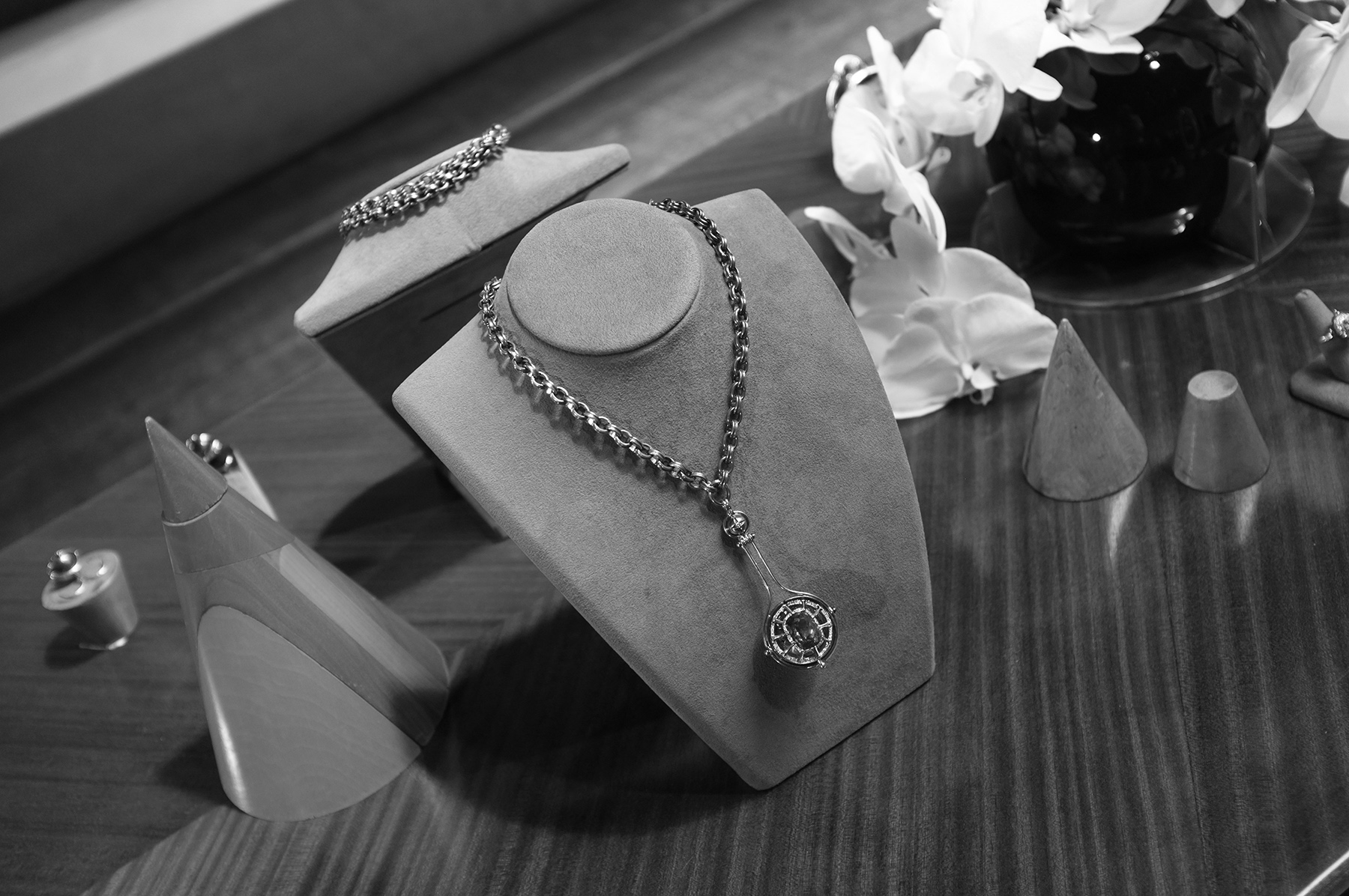Elie Top may just be one of the most glamorous men in Paris. Working silently under the likes of Yves Saint Laurent before his passing, and Alber Elbaz for Lanvin before Elbaz left the helm of the fashion house, Top has gained a keen and sharp insight into the world of luxury jewelry and accessory making. Elbaz’s exit was a perfect excuse for Top to take what he learned as an interminable apprentice and start his own eponymously named label. His new collection, entitled Mécaniques Célestes, is an insight into the ornamental aesthete’s lifelong fascination with all things baroque, classical and talismanic. Gold, diamonds, precious stones and other metals reinterpret the armillary sphere – tiny universes atop a finger, atop a breastbone; perfect and encapsulated. When we met Top, we ambushed him with an interview proposal during a cigarette break from hosting his recent pop up at Maxfield’s in Los Angeles (it was his first ever visit to Los Angeles). Our conversation oscillated between his memories of working with Saint Laurent, his love for jewelry and his new collection.
SUMMER BOWIE: So when you were much younger did you know that jewelry design and accessories were going to be your career path?
TOP: What do you mean by younger? Which age? [laughs]
BOWIE: A child.
TOP: When I was really young I was more into architecture and was sketching very precisely in a maniacal way. Mostly churches and castles. I was very inspired by the 18th century French style and Italian and Austrian things, and was very obsessed with the Baroque period. So not very modern.
BOWIE: Where in France are you from originally?
TOP: I was born in the very north of France, close to Belgium in the countryside. So really a very small village. There were factories because it’s kind of an industrial area, but at the same time, there’s a lot of farms and animals. So it’s a strange mix between both.
BOWIE: So not that many Baroque influences.
TOP: Yeah, I don’t know why I’m obsessed with that! I went to Italy for the first time when I was quite young. I was maybe nine the first time I went to Rome, then I went to Venice, then I went to Bavaria, and I used to go quite often to Versailles and places like that. But around eleven or twelve I decided I wanted to work in fashion and I started to sketch more fashion things...but not especially accessories. It was more general - but then I went to fashion school in Paris at seventeen. I went to work at Yves Saint Laurent when I was around nineteen as a general assistant in the studio when Yves Saint Laurent was still there.
BOWIE: How did you get that job?
TOP: Thanks to school. I went in as an intern for two months and they kept me around which was quite cool. I was doing illustrations. Then Alber [Elbaz] arrived because he was doing the Rive Gauche collections. It was late 90s and that’s how I met him; when I was twenty-one. I think he didn’t know exactly what to do with me and he didn’t have anybody to work on the jewels and accessories in general, because Loulou de la Falaise was no longer doing the jewelry at Yves Saint Laurent. So he just asked me to start working so I started doing sketches and working with manufacturers, which is how I got started. He encouraged me and pushed me to work in this direction. And I was working at the same time on handbags and leather goods. But progressively over the years, I just gave up everything but the jewels because it’s what I liked the most.
BOWIE: What is it about jewelry that makes it so appealing?
TOP: I think it’s quite close to what I used to sketch when I was a child. It’s the same way that I’m looking at it and the way I’m imagining it. There’s always so many variables, and it always involves these architectural problems. As I like to sketch very precisely, everything is the same thing, actually. Like all the castles and all the jewels are the same. I’m very passionate and precise so I can really sketch for hours.
BOWIE: And then you worked for Lanvin as well?
TOP: Yeah, when Alber arrived at Lanvin, he called me and we started to work together immediately.
BOWIE: And do you prefer now working on your own better than for these major fashion houses like Lanvin and Yves Saint Laurent?
TOP: Hmm… It’s very different for me, because for me Alber, and Saint Laurent - and LouLou as well because I worked with her too - they felt like a continuation of my school years and they were really great mentors, because they really helped me. Alber and Loulou encouraged me and taught me a lot. And now I’ve grown up and I can do my own thing. It’s more about that freedom to do something for yourself and not for somebody else, which is very different. It’s more difficult in a way because when you work with my state of mind - I was very devoted to those people - I would do my best to please them and now I have to please myself which is something very different. [laughs]
BOWIE: Were you nervous at first about doing your own thing?
TOP: Yeah. It also took me a long time to find my own aesthetic, because it was so mixed. Like for instance with Alber, I had a lot of freedom but he was always there, so it was a mix of him and me, and it was very connected to the theme of the fashion show so we could do something one season and the opposite the season after. So it was always attached to the collection. Suddenly we were without clothes, and we were without a theme. It wasn’t coming out of me. So, I had to look at my previous work to find the elements that were really me. Because I could see how all the ribbons were completely Alber, and everything which was more Baroque and with all the mixes of materials was more my story. I realized that my story’s all about system and structure, so I tried to extract that. It took me a long time to realize and to find myself. For fifteen years I was working for so many people and a lot of clients and it became more of a mathematical exercise, where you have to find their aesthetic and then create it yourself. It was a sort of a game. But then suddenly I didn’t have anybody else and I didn’t have any other variables to work with.
BOWIE: And what was the difference between what you learned working with Alber Elbaz and Loulou de la Falaise, and what you learned working with Yves Saint Laurent?
TOP: Oh they’re all such different people. [laughs] For Loulou it was more about her own personality. She had a lot of freedom in the way that she could mix things that were very cheap with things that were very expensive. It was more about the way she was thinking about style and the way that she was mixing a lot of ethnic and Bavarian shapes. African themes mixed with Parisian couture. But she used to do it in such a free way because it was completely her own personality; very intuitive. I don’t work like her at all, because she wasn’t really sketching. She was more about taking the elements, mixing them, and it was more organic and a very sensitive experience. And actually Alber is a bit the same in his way of working because he’s not really sketching, but always doing fittings and fittings, and it’s all about words. He talks a lot as he’s trying to find the story and trying to find some keywords to define what he wants. And then he is really all about the body of the woman and...many fittings. But Yves Saint Laurent was the opposite in the way he was working. He was always sketching, very precisely, and if it wasn’t looking exactly like the sketch, he didn’t want the clothes. Alber would just be sketching basic silhouettes, and then he was progressively transforming everything and doing everything directly on the body in the fittings. He wasn’t attached to the sketch.
"At the end, sometimes, there would suddenly be one thing that was so moving, people would really start crying. And this happens so rarely because it is beyond fashion...you’re not talking about fashion anymore. You’re going somewhere else."
BOWIE: And it seems like you have a more specific vision that you put on paper, and then you try to realize it very directly, as opposed to this very sensual experience where you have an idea, and you play until you find it.
TOP: Exactly. I’m really sketching exactly what I want to see with the jewels, and I don’t move from that. Whereas Alber was working like a lot of women - Vionnet, Chanel, Grès - all those women weren’t sketching, but just doing fittings.
BOWIE: Do you have any great memories of Yves Saint Laurent? Any in particular?
TOP: Sometimes. It never happens to me anymore but sometimes--and I think it’s why people are so attached to him--during the fittings we’d have goosebumps. Sometimes when the model would come in and do a twirl in the clothes it was just so perfect, so impressive, so moving that everybody’s jaw dropped. It’s impossible to describe the experience. Even when I’m talking about it I remember it so clearly.
BOWIE: You start to get goosebumps? [laughs]
TOP: And some people would be crying during the show which was really strange because the show, to be honest, was very old-fashioned. At the end, sometimes, there would suddenly be one thing that was so moving, people would really start crying. And this happens so rarely because it is beyond fashion...you’re not talking about fashion anymore. You’re going somewhere else.
BOWIE: It’s very transcendent.
TOP: And I think that’s the reason people were so attached to him. Because it was something else, not only about clothes. He was doing something else.
BOWIE: And did you feel that yourself too?
TOP: Yeah, once I was really crying.
BOWIE: Well can you tell us a little bit about this collection?
TOP: This collection is the first I’ve shown and now I’ve developed a few new pieces and I’ve done some variations on those themes. It’s called Mécaniques Célestes. It’s all about the armillary spheres, the planets, and globes. Actually my work in the beginning was trying to unify my two aesthetic tendencies, which are from my childhood and my industrial side. And I thought it was coming from living in the middle of all these factories, and mechanical and industrial landscapes. Then my fascination for something more Baroque, more precious and narrative came, so I tried to find a way to put these two opposites together in the same piece. So that’s the reason there is this thing that you can hide or show. And when it’s closed it’s a bit more radical and pure. When you open it, for me, you’re telling something more poetic and more narrative. Then I found inspiration from the principles of globes, for instance from the sugar bowls you see in Parisian bars. I saw the way it opens and closes and I was looking in and thought, “oh that’s perfect.” And that was really my starting point. [laughs]
So I had already sketched a few things but couldn’t find exactly what I wanted to put inside, so I was always looking for the perfect matching thing about the system and the mechanical on the inside and outside and what would be the good unity between everything. Then I found an amazing book with the same title called Mécaniques Célestes about the whole collection of these armillary spheres from a really great antique store in Paris. It’s exactly what I needed so when I found it, I sketched everything and that was really the start of it. What I also really liked was how you can always hide the most gorgeous part to give something more playful, but it depends what you wear with it. It all has to do with your own attitude and clothes.
BOWIE: Yeah it’s really quite romantic, this combination of the celestial and the industrial element. If you could describe your work in three words, what would they be?
TOP: Talking about my collection? Strangely, when it came out it was a mix of futuristic and medieval at the same time, and structure is important as well.
You can visit Elie Top's website to see more of the collection and stockists. Intro text by Oliver Maxwell Kupper. Interview by Summer Bowie. Follow Autre on Instagram: @AUTREMAGAZINE




